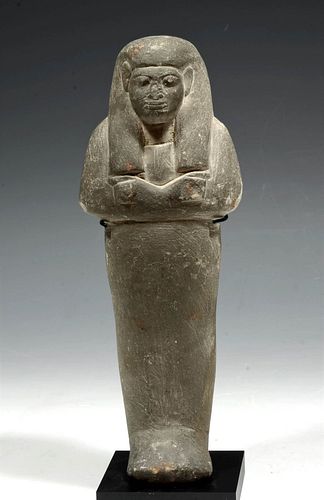Fine Egyptian New Kingdom Limestone Ushabti
Lot 7
About Seller
Artemis Fine Arts
686 S Taylor Ave, Ste 106
Louisville, CO 80027
United States
Selling antiquities, ancient and ethnographic art online since 1993, Artemis Gallery specializes in Classical Antiquities (Egyptian, Greek, Roman, Near Eastern), Asian, Pre-Columbian, African / Tribal / Oceanographic art. Our extensive inventory includes pottery, stone, metal, wood, glass and textil...Read more
Estimate:
$8,000 - $12,000
Absentee vs Live bid
Two ways to bid:
- Leave a max absentee bid and the platform will bid on your behalf up to your maximum bid during the live auction.
- Bid live during the auction and your bids will be submitted real-time to the auctioneer.
Bid Increments
| Price | Bid Increment |
|---|---|
| $0 | $25 |
| $300 | $50 |
| $1,000 | $100 |
| $2,000 | $250 |
| $5,000 | $500 |
| $10,000 | $1,000 |
| $20,000 | $2,500 |
| $50,000 | $5,000 |
| $100,000 | $10,000 |
| $200,000 | $20,000 |
About Auction
By Artemis Fine Arts
Mar 24, 2022
Set Reminder
2022-03-24 10:00:00
2022-03-24 10:00:00
America/New_York
Bidsquare
Bidsquare : Exceptional Antiquities Ethnographic Fine Art
https://www.bidsquare.com/auctions/artemis-gallery/exceptional-antiquities-ethnographic-fine-art-9057
Museum-worthy examples of classical antiquities (Egyptian, Greek, Roman, Near Eastern), Viking, Far East / Asian, Pre-Columbian, African / Tribal, Oceanic, Native American, Spanish Colonial, Fossils, Ancient Jewelry, Fine / Visual Arts, so much more! Artemis Fine Arts info@artemisfinearts.com
Museum-worthy examples of classical antiquities (Egyptian, Greek, Roman, Near Eastern), Viking, Far East / Asian, Pre-Columbian, African / Tribal, Oceanic, Native American, Spanish Colonial, Fossils, Ancient Jewelry, Fine / Visual Arts, so much more! Artemis Fine Arts info@artemisfinearts.com
- Lot Description
Ancient Egypt, New Kingdom, 18th to 20th Dynasty, ca. 1550 to 1077 BCE. An ancient Egyptian ushabti, carved from a single piece of limestone standing with fused legs and feet as a mummiform figure with hands crossed atop the chest. The serene countenance is composed of almond-shaped eyes, a broad nose, full lips, and smooth rounded cheeks and chin, all beneath a simple tripartite wig with cupped ears at the sides. Ushabti were placed in tombs as grave goods, created to do manual labor for the deceased in the afterlife. As a result, they are frequently depicted with arms crossed, holding agricultural tools, and baskets. This figure is of a larger size with excellent preservation to the face! Size: 3" W x 8.1" H (7.6 cm x 20.6 cm); 8.4" H (21.3 cm) on included custom stand
Ushabti were first introduced in the Middle Kingdom as substitutes for the mummy in case it was destroyed. During the Second Intermediate Period inscribed wooden figures called shawabtis (after the Egyptian word for wood, shawab) began to be placed in tombs. During the New Kingdom, ushabti assumed a new role as servant figures for the deceased. They were now depicted with agricultural equipment. By the Third Intermediate Period, the number of shabti placed in the tomb was set at 401 (365 workers and 36 overseers). During the Late Period the tomb figures became known as ushabtis ('answerers'), these figures represented servants who would magically answer when called upon to perform agricultural duties for the Pharaoh (in the form of Osiris) in the afterlife. Their main function was to ensure the individual's comfort and freedom from daily labor in the next life.
For a similar example please see the Metropolitan Museum of Art's website, accession number: 86.1.23.
Provenance: private New York, New York, USA collection; ex-Dr. Junius Bouton Bird (1907-1982), American Museum of Natural History New York City, born in Rye, New York, was an American archaeologist who was appointed curator of South American Archaeology at the American Museum of Natural History in 1934), acquired from his ancestor Albert Shaw (1857- 1947), Author, Historian, Editor of the Review of Reviews, member of the American Antiquarian Society.
All items legal to buy/sell under U.S. Statute covering cultural patrimony Code 2600, CHAPTER 14, and are guaranteed to be as described or your money back.
A Certificate of Authenticity will accompany all winning bids.
PLEASE NOTE: Due to recent increases of shipments being seized by Australian & German customs (even for items with pre-UNESCO provenance), we will no longer ship most antiquities and ancient Chinese art to Australia & Germany. For categories of items that are acceptable to ship to Australia or Germany, please contact us directly or work with your local customs brokerage firm.
Display stands not described as included/custom in the item description are for photography purposes only and will not be included with the item upon shipping.
#170394Surface wear as shown, with minor abrasions and wear to nose, elbow, hand, and lips, and small chip on base, otherwise intact and excellent. Great preservation to details.Condition
- Shipping Info
-
All shipping is handled in-house for your convenience. Your invoice from Artemis Gallery will include shipping calculation instructions. If in doubt, please inquire BEFORE bidding for estimated shipping costs for individual items.
-
- Buyer's Premium



 EUR
EUR CAD
CAD AUD
AUD GBP
GBP MXN
MXN HKD
HKD CNY
CNY MYR
MYR SEK
SEK SGD
SGD CHF
CHF THB
THB














